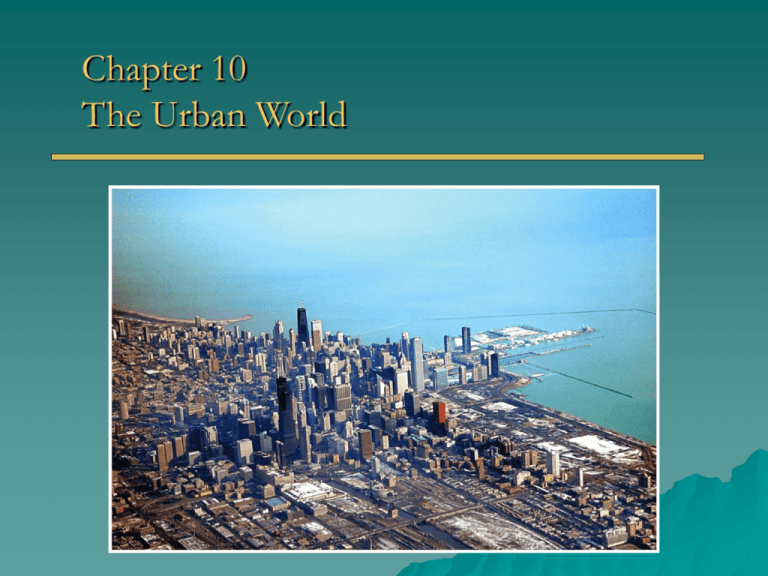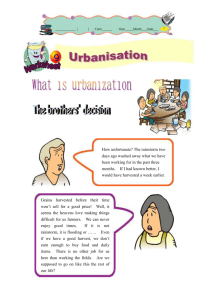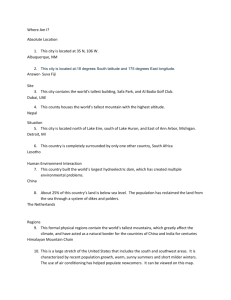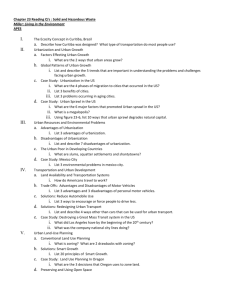Lecture - Chapter 10 - The Urban World
advertisement

Chapter 10 The Urban World Overview of Chapter 10 o Population and Urbanization • • o City as an Ecosystem • • o Environmental Problems in Urban Areas Environmental Benefits of Urbanization Urban Land Use Planning • • o Characteristics of Urban Population Urbanization Trends Transportation and Urban Development Suburban Sprawl Making Cities More Sustainable Population and Urbanization o By 2007 or 2008, half of the world’s population will live in urban areas Population and Urbanization o Urbanization • o Jobs define urban vs. rural, not populations • • o Process in which people increasingly move from rural areas to densely population cities Rural area occupations involve harvesting natural resources Urban area occupations involve jobs not connected with natural resources People are moving to cities due to decrease in employment opportunities in rural areas Characteristics of Urban Population o Basic characteristics of city populations: • • • • Diverse population in terms of race, ethnicity, religion and socioeconomic status Younger population than local rural area More males in developing nation cities More females in developed nation cities Urbanization Trends o Urbanization is increasing rapidly • o Especially in developing countries World’s 10 largest cities are in developing countries The Top Skylines in the World Hong Kong, China Hong Kong has a whopping 43 buildings over 200 metres tall, 30 of which were built in the year 2000 or later. It also boasts four of the 15 tallest buildings in the world. Hong Kong’s skyline shows a large selection of distinct sky-reaching towers. Metro/Urban Population: 6.9 million http://citynoise.org/article/3432 The Top Skylines in the World Chicago, Illinois When Chicago built its first steel high-rise in 1885, it was not the tallest structure in the world but the first example of a new form of engineering that would change nearly every city on earth. Chicago has 19 buildings over 200 metres tall (three of which are among the top 20 tallest buildings in the world, including the tallest in North America). Metro/Urban Population: 9.5 million The Top Skylines in the World Shanghai, China China's biggest and most advanced city, Shanghai was said to be the most cosmopolitan city in the beginning of the 20th century, but lost its glory during the “Mao era”. It is now quickly regaining its position as one of the biggest economic powerhouses in the world as well as a showcase of modern architecture. In Shanghai you’ll find 25 structures that are over 200 metres tall, one of which is the insanely tall, the 468m downtown Oriental Pearl TV Tower. Metro/Urban Population: 13.1 million The Top Skylines in the World Dubai, United Arab Emirates Already home of the world's tallest all-hotel building and the tallest allresidential building in the world, AND currently proposed to build the world's tallest building. All seven structures in this city at over 200 metres tall were built in 1999 or later - that's how new this city is. Metro/Urban Population: 1.6 million Palm Islands, Dubai, United Arab Emirates Burj, Dubai World’s Tallest Human Structure Urbanization Trends o Urban Agglomeration • Urbanized core region that consists of several adjunct cities or megacities and their surrounding developed suburbs United States Urban Agglomerations (Population of 50,000 or above) Substandard Housing o Typically occupied by squatters • o No city services • o o Illegally occupy unsafe housing Water, sewage, garbage collection, police and fire protection 1/3 of urban population in developing countries are squatters Homelessness is present in lower numbers in developed countries Land Use- Park City, Utah Undeveloped Open Space Full Satellite View of City Environmental Problems in Urban Areas o Growing urban areas affect land use patterns • • o Brownfields • o Fragment wildlife Encroach wetlands, forests, desert, etc. Urban areas of abandoned industrial or residential sites that may be contaminated from past use Impermeable surfaces and urban runoff discharged into waterways • Motor oil, lawn fertilizers, heavy metals Environmental Problems in Urban Areas o Long commutes • • o o Traffic congested streets Buildup of airborne emissions due to cars and industry Noise pollution Urban heat island • • • Local heat buildup in an area of high population density Affect local air currents and weather conditions Contribute to buildup of pollutants- dust domes Urban Heat Island Temperature variations on a summer afternoon Environmental Benefits of Urbanization o Well-planned city can benefit the environment • • o Reduces pollution Preserves rural areas Compact Development • • Design of cities where residential buildings are close to shopping, jobs and public transportation Ex: Portland, Oregon Urban Land Use Planning o o Land use based on economic concerns From center of city outwards: • • • • o City center- Central Business District (highest taxes) Residential properties (lower taxes than city center) Land intensive businesses (even lower taxes) Suburbs (lowest taxes) Parks and green space are interspersed Urban Land Use Planning o Land Use Planning • o o Process of deciding the best use for undeveloped land in a given area Influenced by political and economic factors Regulated through zoning • Cities divided into use zones • • • • Commercial Residential Industrial Property owners must meet zoning ordinances Transportation and Urban Development o o Transportation availability affects city’s spatial structure Ex: An east coast US city • • • (a) 1700-1850 (b) 1850-1910 (c) 20th century Suburban Sprawl o Suburban Sprawl • o Problems • • • • o Patchwork of vacant and developed tracts around the edges of cities Loss of wetlands Air pollution Water pollution Loss of biological habitat 11 states now have new growth management laws (Smart Growth) Making Cities More Sustainable o Characteristics of a sustainable city • • • Clear, cohesive urban growth policies Efficient use of energy and other resources Reduction of pollution and waste • • • • • Reuse and recycle materials in waste stream Large areas of green space Designed to be people-centers, not car-centered Food grown IN the city (rooftop gardens) Compact development Copenhagen, Denmark A People-centered City Sustainable Cities Case in Point- Curitiba, Brazil








